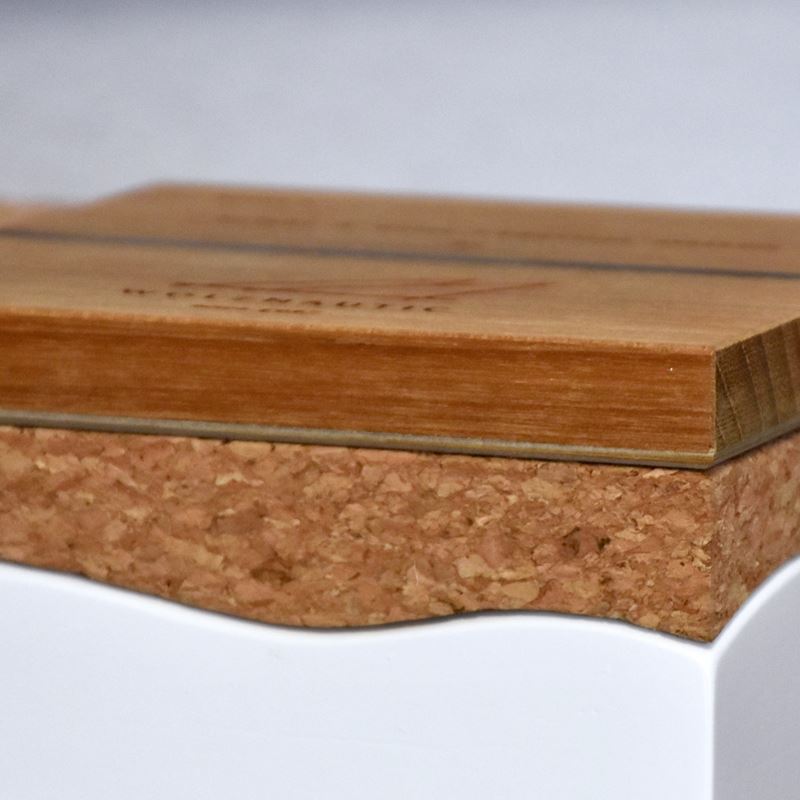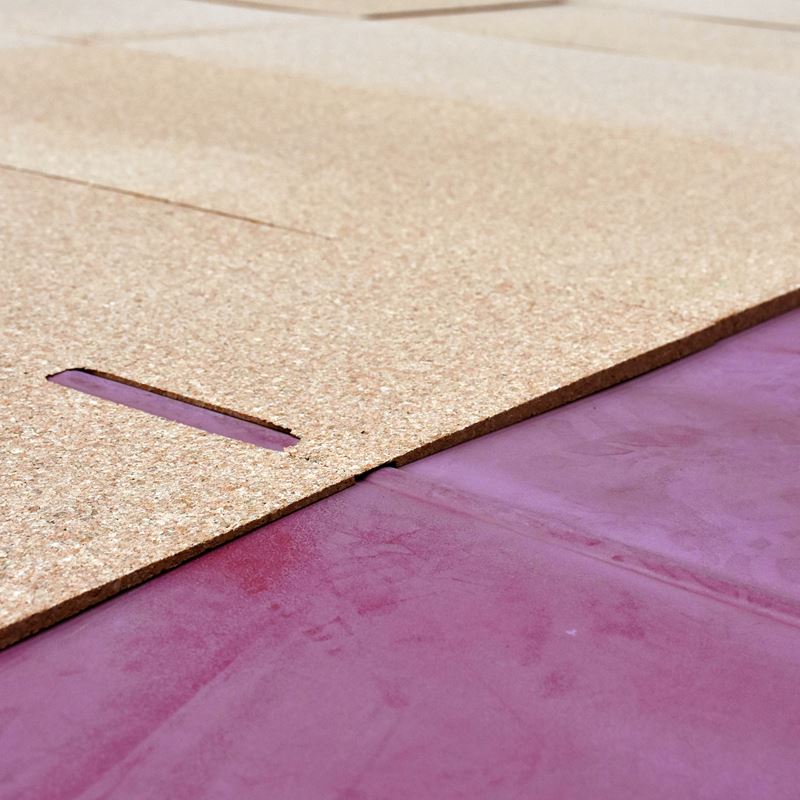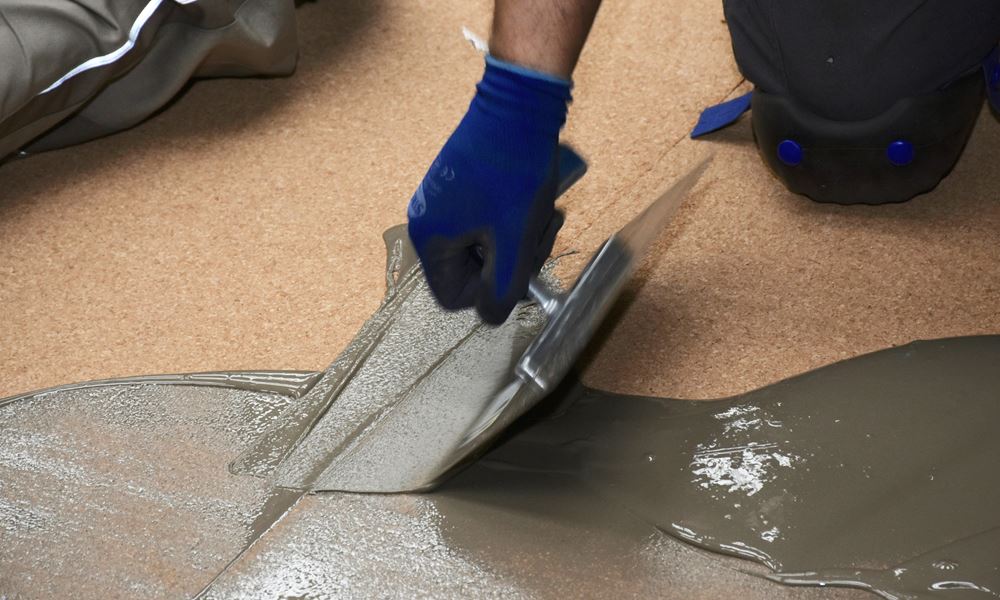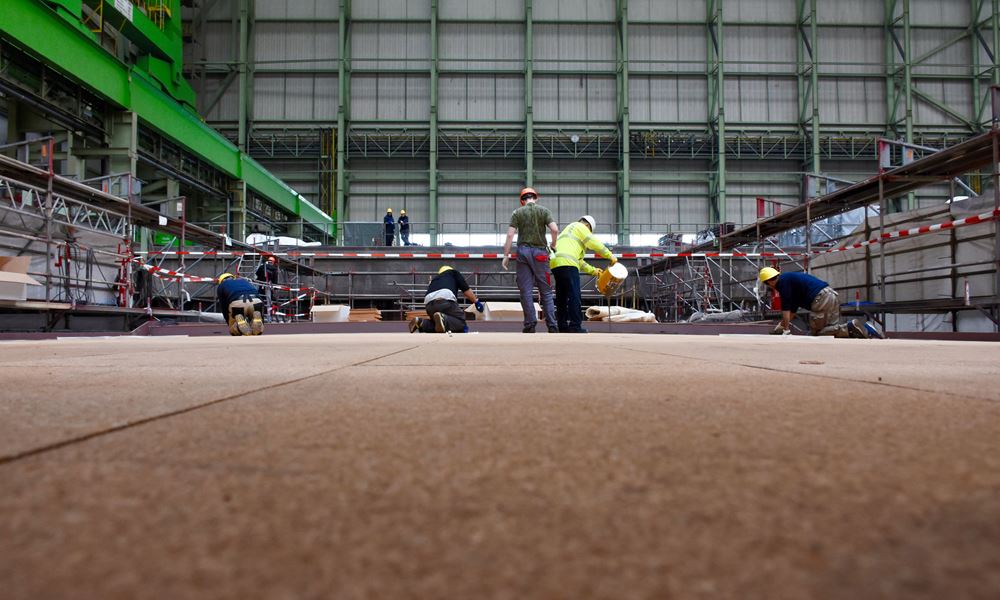Innovation in deck construction for passenger vessels with cork technology.
Today there is chronic pressure on shipyards’ and shipowners’ margins, while the IMO guidelines call for “safe, secure and efficient shipping on clean oceans”. At the same time, passenger numbers are growing globally, as are new builds and ship modernizations.
If the building and operation of passenger vessels are to become more competitive and the goals of “lean shipping” and “green shipping” are to be realized, then cork has a very bright future in deck construction. No other material combines technical and functional properties in such a perfect balance.
Optimisation of deck assembly and upstream processes
Since 2009, WOLZ NAUTIC has been pioneering in cork technology, significantly improving deck assembly in terms of man-hours, material costs, material handling and finishing.
These advantages are made possible by the unique features of cork technology.
Cork can be joined with conventional industrial adhesives and various substrate materials (wood, composites, aluminum, steel), and can be industrially processed with conventional tools or state-of-the-art machines.
The deck surface measurement technique developed by WOLZ NAUTIC is accurate down to the millimeter and uses 3D laser trackers to calculate volumes and ideal surfaces for subsequent levelling of the ship's deck.
The cork material is machined on five-axis CNC machines so that the three-dimensional contours of their underside makes them a precise fit with the ship's deck, while the upper surface is perfectly smooth for the final deck covering. A special PU-impregnated cork composite, at least 4 mm thick is used for this purpose. In principle, there is no upper limit to the material thickness, so they are able to fully compensate for large deformations of the hull deck.
Vacuum bonding techniques are used to connect the hull, cork composites, and deck coverings.
This technology eliminates the often very labor- and time-intensive handling at the shipyard with huge volumes of heavy levelling compounds and spatulas. Cork does not flow and does not swell under load; it does not need to dry and will not tear.
Precision prefabrication and continuous availability of current real data in the use of cork technology mean that the production and assembly processes become more transparent and easier to plan. Given that the manpower-intensive areas of large shipyards still have to contend with relatively high productivity losses (30% of working time is spent on procuring and processing information, 19% on procuring materials and auxiliary equipment, 21% on preparing construction and assembly areas, 7% on rework, and therefore only 22% on the actual construction work), cork technology enables tangible improvements in project management to be achieved.
Optimisation of carrying capacity
Lightweight construction with cork technology reduces the deck weight of passenger vessels by 30% to 50%, thereby enabling a larger passenger and/or cargo capacity.
Depending on their objectives and requirements, ship operators can use this weight advantage to enhance equipment, comfort, catering or on-board entertainment, or to increase the size and number of cabins on the ship. In response to rising passenger expectations in terms of comfort, shopping, fitness and variety, optimizing carrying capacity enables cruise operators to gain a competitive advantage. This also includes the highly sustainable nature of cork as a natural material plus the first-class footstep sound and thermal insulation offered by cork-based deck construction.
Optimizing routes and extending the season
For the river cruise ships built by MV WERFTEN, a weight reduction of 7 tons per ship is achieved by using cork technology alone.
The resulting reduction in draught allows ships to operate in relatively shallow waters that were previously unnavigable for such vessels. It is precisely these waters, such as bays, river tributaries, and canals that offer scenic landscapes, making them attractive for passengers. Less draught also means that ships can operate at times when water levels are low (e.g. dry summers, low tides), so their cruising season is extended.
More green shipping and greater IMO compliance
“Safe, secure and efficient shipping on clean oceans” is future-proof. Indeed, this guideline set down by the International Maritime Organization (IMO) provides the framework for the construction and operation of ships that will become established in global markets. The “strategic goals for marine technology”, formulated in 2015 in the German Maritime Research Program, are also ambitious, and demonstrate the potential of cork technology in terms of efficiency and sustainability. For example, the target is to halve ship emissions by the year 2020, thereby saving a corresponding amount of fuel and enhancing the green footprint.
The fact that a 1 ton reduction in ship mass produces a fuel saving of roughly 1 tonne per year may be an old rule of thumb, but it's a step in the right direction too. Cork is lightweight, and also an ecologically and economically valuable material for deck construction. Combined with precise prefabrication, cork is making a constructive contribution to more green shipping and greater IMO conformity.
Wolz Nautic
Wolz Nautic, founded in 1927 in Würzburg, Germany, is a global leader in the prefabrication of cork-based ship decks, and makes approximately 20,000 m2 of decking per year. The company is as innovative as it is traditional. It is also fully certified and has developed cork technology in deck construction through to industrial maturity, patenting it in 2009.
MV Werften
MV WERFTEN comprises of three shipyards in Wismar, Rostock and Stralsund in the German state of Mecklenburg-Vorpommern (MV) and has some of the largest docks and covered fabrication facilities in Europe. In their 70-year history, the three shipyards have designed, produced and fitted out around 2,500 sea-going newbuilds, including two AIDA cruise vessels.




